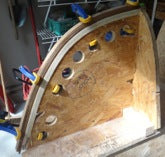Canoe Story by BuggF
By BuggF
I decided to order some Bear Mountain Boat canoe plans after seeing a beautiful example a friend had built. Most of my canoeing is solo, therefore, the Rob Roy looked like a good choice for a first canoe. The plans were straightforward and adequately detailed. As a retired person with an aversion to schedules, I proceeded very slowly, so the task was not difficult. The Rob Roy was completed in about 9 months of very part time work. A year later I completed a second canoe in about 3 months. Both canoes are built from reclaimed wood; an eastern red cedar from the front yard and a poplar tree downed by tornado in 2011. (Using reclaimed wood is in the same practical benefit category as eating organic groceries). Rob's inner and outer stems, gunnel and hollow thwarts are hickory. Bugg Boat's inner stems are poplar with 100+ year old oak for the outer stems and outer gunnels (from a historical house restoration project). The thwarts are hollow poplar tubes. The Rob Roy is great fun to paddle and weighs 33 lb, light enough for easy loading into the pickup bed by one old guy. The paddling is so fun compared to my chubby plastic store bought canoe that I decided to make the second canoe even slimmer and trimmer. My Rob Roy is 13 ft long and 27 in. beam. The Bugg Boat is 14 ft. long and 24 in. wide at the gunnel with a trace of tumblehome. The Bugg Boat weighs in at 30 lb. The seasoned cedar and poplar are near equal density, but for the Bugg Boat I had learned how better to squeegee away excess epoxy.
I made a cedar strip seat for the Rob Roy, but determined that a boat cushion is more comfortable for miles long day trips (20 mi. is my current longest). Keeping the top side visible is important, thus the very low seat positions. Seat backs are the only lumber store wood, sawed from a $2.59 western cedar fence board. Velcro is this redneck's duct tape. Rob's seat is velcroed to a permanent thwart. Bugg Boat's seat is velcroed to a movable thwart/velcroed to the gunnel. (If you make good initial placement decisions, there's no need for a movable thwart!) Both paddles have cedar strip blades and the longer one has a hollow poplar shaft (2 lb paddle). Footrests are adjustable on long Velcro strips and the GPS is on Velcro. Some say if you need to know speed, distance, time, where you are... then you don't understand paddling. I guess I like data (5.7 mph is the max I've seen, but I'm slow)
The joy of making strips - In Alabama a person with a band saw mill is easy to find. I designated 1 in. boards, so the sawyer cut my logs into boards 1 in. minus the saw blade thickness, or very consistently 7/8 in. thick. No planing process is needed because the sawing and bead/cove cutting puts a smooth finish on each strip surface. And, each finished strip is 1/8 in. wider than if you started with store bought one bys.
It takes only about two of the wider boards shown to make a canoe! The bead and cove cutter is one router bit used in two positions. There is a 6 month drying time between boards in the pickup and cutting strips. Both cedar and poplar dried quickly. Other woods might take longer.
Miscellaneous construction notes - Steaming to bend the stem laminates might be a fun thing to learn, but, I gave up and cut the very stiff/brittle oak to thinner (3/16 in.) strips then glued with Elmer's Max and clamped to shape. The poplar is much more flexible and 1/4 in. thick strips worked.
I used a 23 gauge pin nailer to attach strips to mold station forms. These are easy to pull out and leave a tiny hole. 8 foot logs are the longest I can confidently load and haul. The bead/cove system makes splicing practical and strong, no need for full length strips. Staggered splices are well trapped between upper and lower strips and do best when not at mold stations. My paddling with these canoes has all been in Guntersville Lake or on the Tennessee River close to home (Huntsville, AL). Best adventures have been paddling with family and experiencing the many lake shore creatures. If you've only motored down a river you'll be amazed at how visible the creatures are as you glide silently close to the shore.
My current project is learning to forward row the Bugg Boat! When you've finished your canoe, disassemble and store the strong back parts and station molds. DON'T use the wood for various other projects! It's great fun to think about a design of your own and give it a try. Hmmm, wonder what it would look like to mount the molds on the strong back in random order and start gluing strips? :) Go build you one!!














